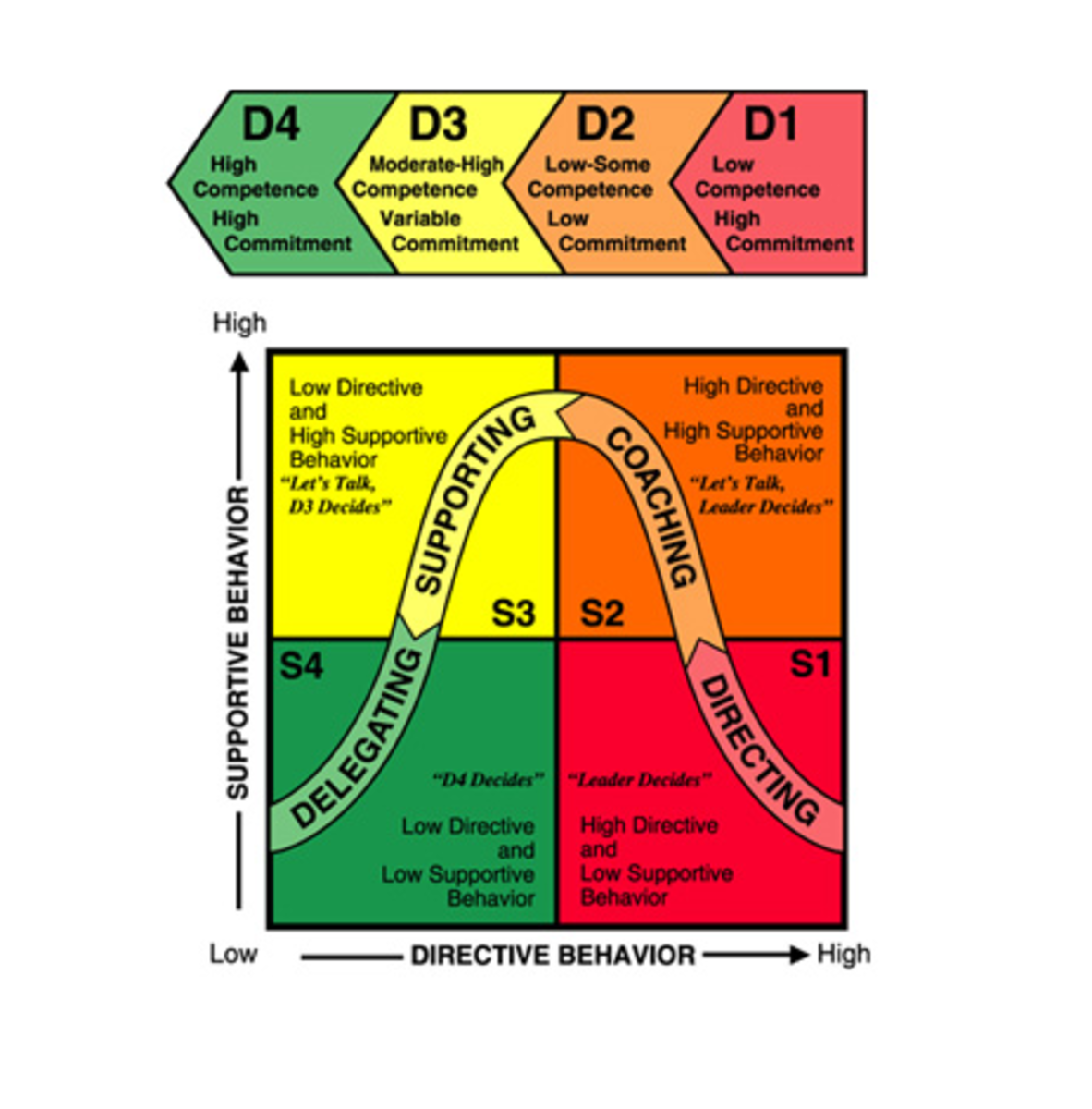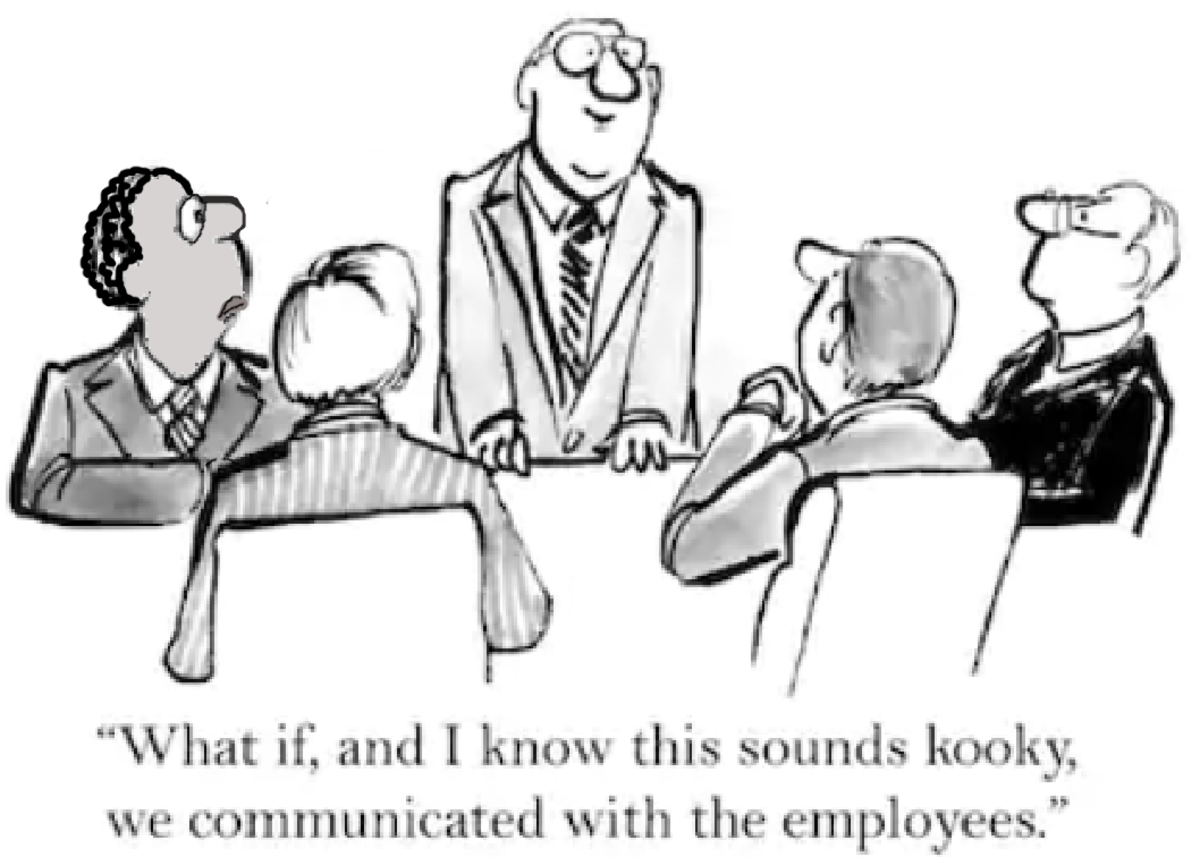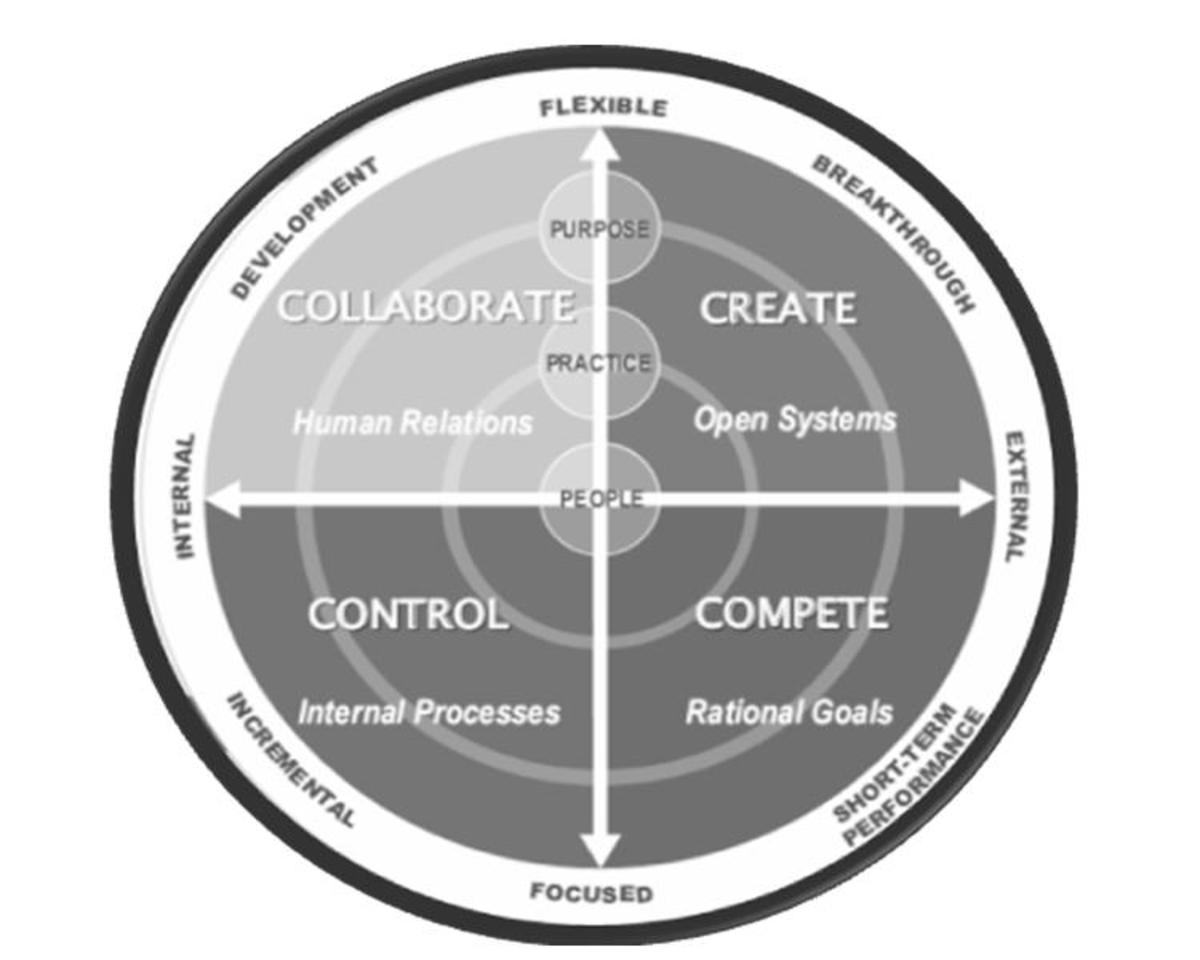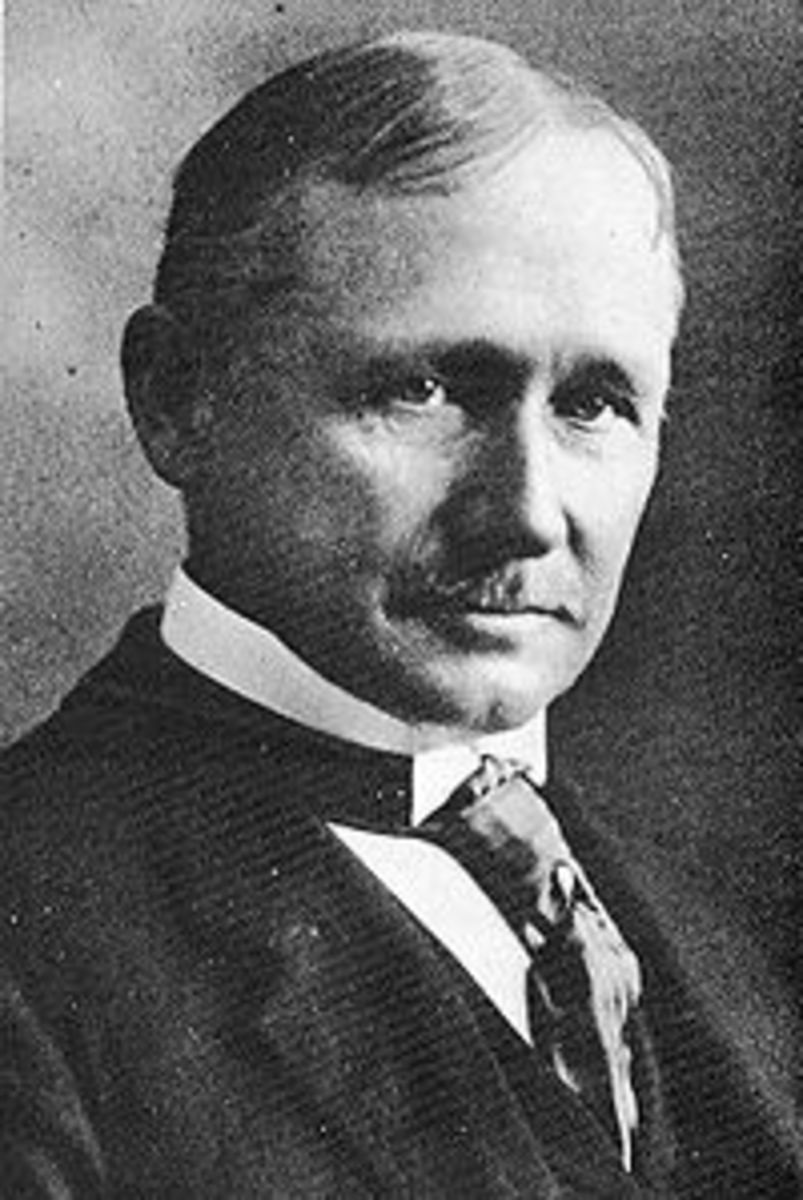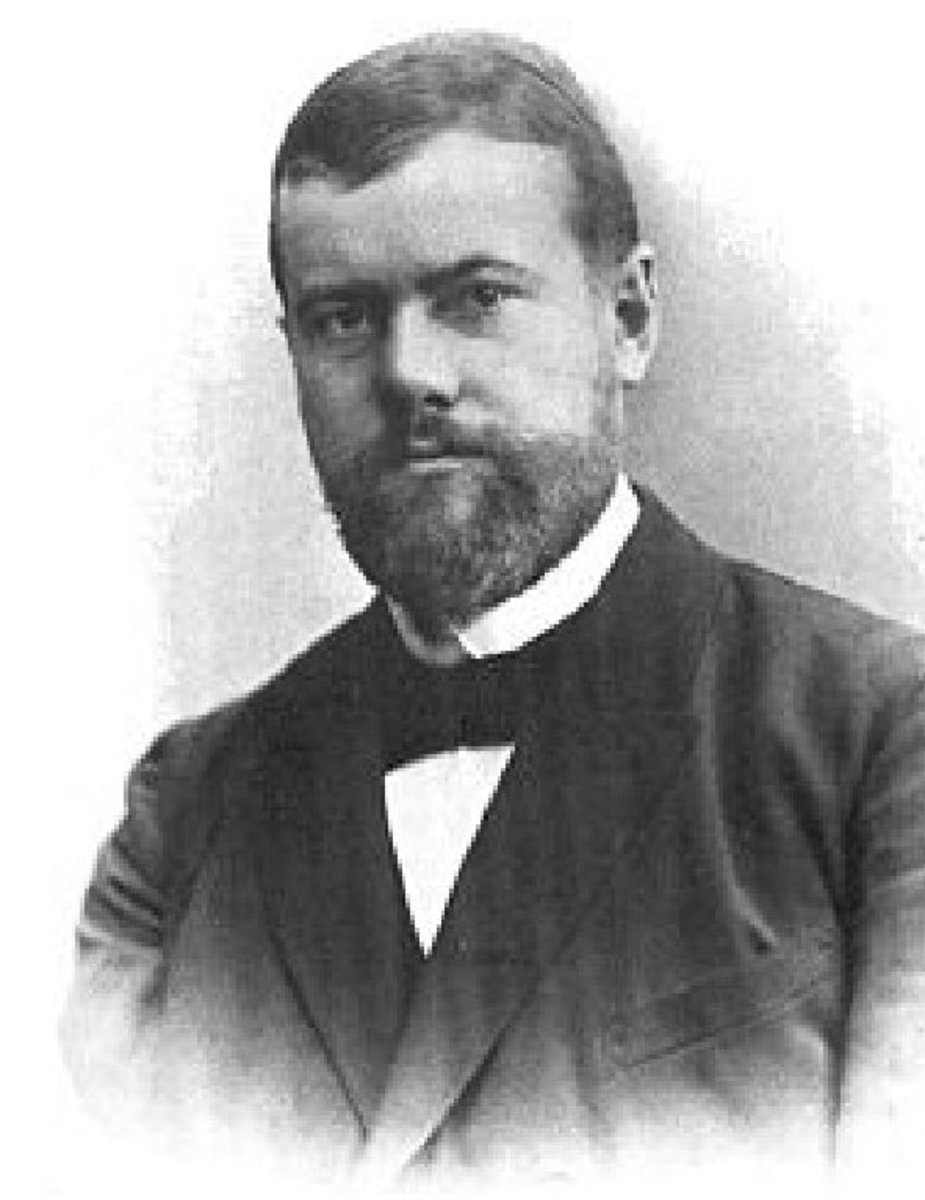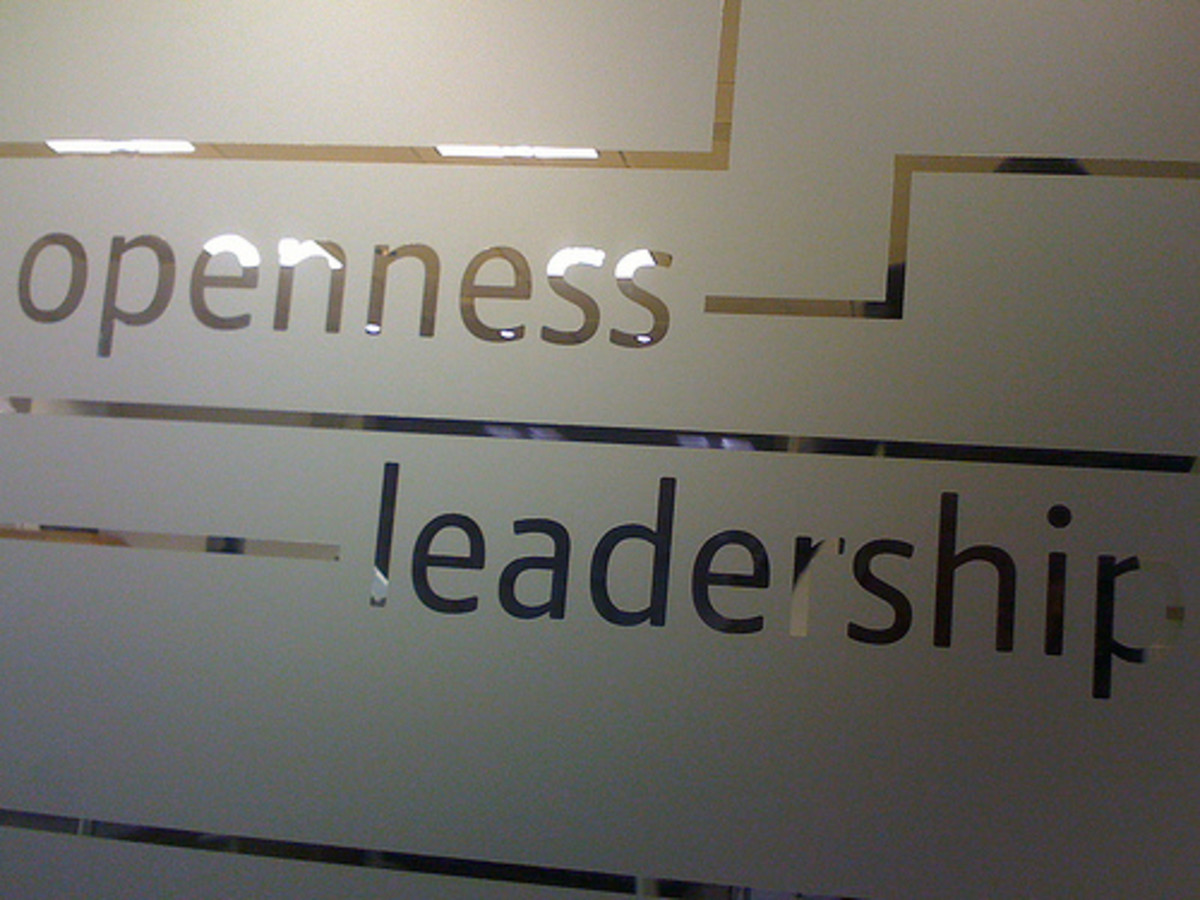Kingdom-centered Leadership - A Theistic Approach to Integral Leadership for Societal Transformation
Article Preview
In the face of challenges and complexities presented to businesses and organizations at the dawn of the 21st century, some researchers and practitioners in the field of organizational leadership called for more integrative theoretical models of organizational development that balance the needs of individuals in terms of personal growth and well-being; the needs of the organization in terms of financial stability and mission fulfillment; and the needs of the external environment in terms of positive societal outcomes and conditions. In answer to this call, this article examines four models for integrative organizational leadership before postulating an integral model based on a theistic worldview. Specifically, this paper proposes Kingdom-centered leadership which is an integral system construct of organizational leadership based on principles found in the Christian Scriptures as exemplified in the life of Jesus Christ and advocated by his followers. Furthermore, this article proposes Kingdom-centered leadership is a leadership style that is spiritual, based on agapao love, servant-oriented, participative, 360˚, and transformational.
Keywords
Key words: leadership, Kingdom-centered, entrepreneurship, spiritual, servant, integral theory, transformational, 360-degree, participative.
Kingdom-centered Integral Leadership - Introduction
Organizational leadership in the 21st century is a complex endeavor compounded by the onslaught of increased globalization; the unfettered expansion of the super information highway; and, in the wake of recent organizational crises and ethical failures, a renewed search for meaning in the workplace (Prewitt, 2004; Haladay, 2006; Küpers, 2007). The demands of this complex and rapidly changing landscape require new leadership perspectives in order to respond in appropriate manners (Haladay). External and internal environments of business are increasingly fragmented, ambiguous, and changing, necessitating modification of conventional concepts of leadership and followership (Küpers, 2007). The old ways of thinking including prevailing leadership theories and business models forged by “modernist assumptions of winners and losers, power and control, and local rather global interactions,” fail to give leaders the means to address the dilemmas and challenges confronting them on a daily basis (Wheatley, 1992; Prewitt, p. 327). Organizations of all types are sent scrambling to develop or adopt new paradigms of organizational development and leadership to cope and thrive or perish (McNamara, 1997). Accordingly, researchers in the field of leadership are positing new theoretical constructs and models to help leadership practitioners in organizational development address the complexities associated with the demands of the business environment in the second decade of the 21st century and beyond (Haladay).
In the face of challenges and complexities presented to businesses and organizations at the dawn of the 21st century, some researchers and practitioners in the field of organizational leadership called for more integrative theoretical models of organizational development that balance the needs of individuals in terms of personal growth and well-being; the needs of the organization in terms of financial stability and mission fulfillment; and the needs of the external environment in terms of positive societal outcomes and conditions (Prewitt, 2004; Haladay, 2006; Küpers, 2007; Wilber, 1995, 2000; Mulford & Eldred, 2009).
Prewitt (2004) summarized the call for more integrative approaches to organizational leadership when he wrote
In the age of postmodernism and the subsequent age of globalization, organizations are recognized as increasingly complex, networked, emotional, and chaotic. [Accordingly] organizations navigating these times require flexibility, shared mental models, quick responsiveness, and mutual accountability [with] sophisticated, adaptive, empowered workers in a fractal organizational structure rather than mindless drones waiting for decisions to be made by a command-and control bureaucracy. (p. 328).
Furthermore, Prewitt (2004) highlighted that integral leadership involves
1. Understanding the power of organizational culture.
2. Using storytelling for developing a shared reality.
3. Orienting towards humanistic theories of leadership.
4. Being acquainted with the notion of emotional intelligence.
5. Taking ethics leadership beyond the superficial.
6. Focusing on integrating the soul with the worker. (p. 329).
The purpose of this paper is to present a theistic approach to integral leadership for social transformation. This endeavor was undertaken to present a comprehensive model of organizational leadership that addresses the complexities and challenges presented to businesses and other organizations operating around the globe in the 21st century and beyond. In order to accomplish the stated purpose, the researcher briefly builds on four integrative models including (a) Fry and Hattwick’s (2004) integrative approach to business and organizational behaviors; (b) Wilber’s (1995, 2000) integral approach to life and existence as a whole; (c) Axialent’s 3cube Matrix; and (d) Mulford and Eldred’s (2009) model of Kingdom entrepreneurship.
Integrative Approaches to Life, Business and Organizations
Fry and Hattwick (2004), Wilber (1995, 2000), and Kofman (2004) presented integral models to life, business and organizations. Fry and Hattwick presented an integrative model of the many facets of business and organizational behavior; Wilber, an integrative model of developmental psychology that highlighted the needs and behaviors of individuals within organizations; and Kofman, a combination of the two.
An integrative approach to business. Fry and Hattwick examined the practices of three business icons e.g. Dell, Best Buy, and Southwest Airlines, and postulated an integrative approach to business that addressed all facets of an organization and organizational behavior. As a result of their research, Fry and Hattwick constructed a model to outline the type of thought process business leaders use to make sound judgments and decisions and to demonstrate how the pieces of a business enterprise fit together to make a whole. Recognizing that “owners or managers of every business make decisions related to marketing, finance, human resources, facilities, and other elements of business,” Fry and Hattwick sought to show how decisions in one area of a business enterprise affect other areas. Figure 1 illustrates their integrative model and shows that development and redevelopment of an organization is a continual process. Their model breaks the general operations of a business organization to five major processes including
1. Vision and Mission
2. Determining Indicators of Business Success
3. Assessing the Environment and Its Impact
4. Providing Excellence in Products and Services
5. Evaluating Results and Making Changes
An integrative model of life. Whereas Fry and Hattwick (2004) offered an integrative model of the common behaviors of business organizations, Wilber (2000), an evolutionary psychologist, offered a theoretical construct of developmental psychology that sought to address the needs and behaviors individuals in relation to their personal self, organization, and their external environment. After a three year study, Wilber posited that (a) all systems of life in the universe are sets of arranged hierarchies emanating from the most simple of structures or organisms and building to systems of greater complexity and that (b) individuals and organizations observe and evaluate phenomena or events on three simultaneous dimensions including (a) how it will affect him/her personally; (b) how it will affect his/her chosen collective community; and (c) how it will impact the collective society at large. From those two discoveries, Wilber (1995, 2000) devised a four quadrant developmental model of human consciousness, behavior, and interaction that addressed the internal needs of individuals, their relationships with the organizations to which they belong, and the external environment. Figure 2 depicts an integral map with the four quadrants of Wilber’s model. The four quadrants divide by internal-external along the vertical axis and individual-collective along the horizontal axis with (a) the upper left quadrant corresponding to the individual-internal including self and consciousness; (b) the upper right quadrant corresponding to the individual-external including personal outward behaviors; (c) the lower left quadrant corresponding to the collective-internal including culture and worldview; and (d) the lower right quadrant corresponding to the collective-external including the social system and environment at large. From Wilber’s (2000) integral system approach, researchers and practitioners in the field of leadership looked for ways to apply the integral construct to organizations and organizational leadership (Küpers, 2007; Reams, 2005; Pauchant, 2005; Prewitt, 2004; and Haladay, 2006).
Combining integrative approaches. Taking a cue from Wilber’s discoveries in the light of the various behaviors and practices of an organization e.g. those highlighted in Fry and Hattwick’s model, Kofman (2004) observed,
“Organizations achieve exceptional results when they integrate three critical dimensions:
1. The traditional formal business dimension (the It), where success is measured by economic value.
2. The collective human dimension (the We), where success depends on trust and effective relationships.
3. The individual dimension (the I), where success means that people are enthusiastically committed to a shared vision —have the skills to pursue it— and become fulfilled human beings because of that.” (p. 1).
In light of this Kofman and his colleagues at Axialent devised an in-depth approach to organizations and wove it together with Wilber’s (1995, 2000) three dimensions of experiential interaction e.g. I, we, and it in order to formulate a comprehensive model of organizational development and leadership. Kofman et al. (2004) organized the matrix with (a) Wilber’s (1995, 2000) experiential dimensions e.g. 3rd-person technical orientations, the 2nd-person collective, and 1st-person individual placed along the top and (b) the three dimensions of their an in-depth approach e.g. platform, process, and product aligned along the left side. Kofman’s scheme is presented in Figure 3.
Kofman et al (2004) combined their platform level with Wilber’s (1995, 2000) experiential dimensions to demonstrate basic foundational attitudes of organizations and individuals within organizations. The foundational attitudes included
1. Mental models on the individual dimension including (a) unconditional responsibility, (b) learner attitude, and (c) emotional competence;
2. Culture on the collective dimension including (a) shared mission, (b) shared values, and (b) shared practices;
3. Business infrastructure on the technical dimension including (a) information technology, (b) organizational structure, and (c) facilities.
Next, Kofman et al combined the process level of their scheme with Wilber’s dimensions to show behaviors and processes of organizations and individuals within organizations that flow from foundational attitudes. Those behaviors and processes include
1. Behaviors on the individual dimension including (a) value-based actions, (b) self-reflection, and (c) skillful expression;
2. Interactions on the collective dimension including (a) authentic communication; (b) generative negotiations; and (c) impeccable commitments;
3. Business processes on the technical dimension including (a) operations, (b) strategic planning, and (c) product development.
Finally, Kofman et al. set forth the ultimate outcomes of attitudes and behaviors and processes by combining the product level of their scheme with Wilber’s dimensions with
1. Integrated self culminating on the individual level including (a) personal effectiveness, (b) increased consciousness, and (c) enthusiasm;
2. Productive community culminating on the collective level including (a) alignment, (b) solidarity, and (c) trust;
3. Shareholder value culminating on the technical level with (a) profit growth, (b) revenue growth, and (c) mission fulfillment.
Fry & Hattwick's Integrative Business Model
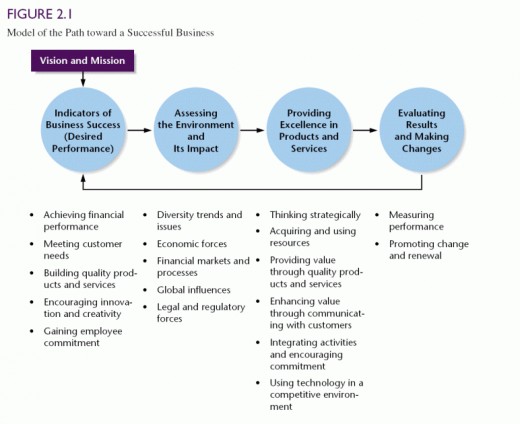
Ken Wilbur's Integral Map
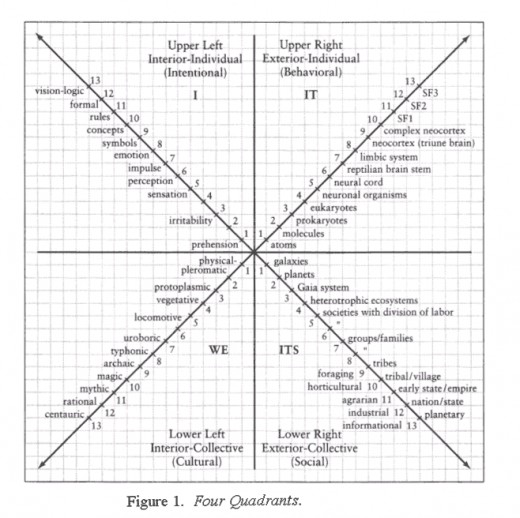
Axialent’s 3cube Matrix
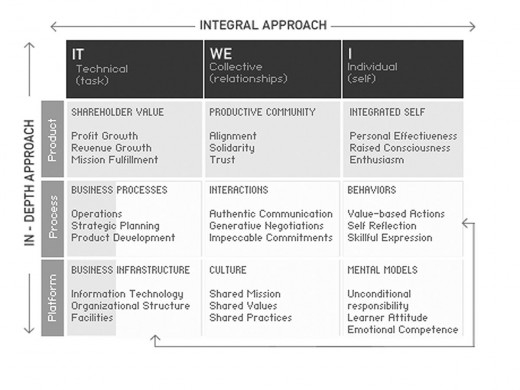
Kingdom Entrepreneurship
Adding to the complexity organizations faced in the first decade of the 21st century is the number of crises and subsequent failures brought on by unethical practices by leaders and other members of organizations in American corporations (Küpers, 2007). As a result, the concept of spirituality and meaning at the workplace received heightened concern in academic literature from the mid-1990s to 2010 (Brook & Parker, 2009). In that time researchers and practitioners in the field of leadership and organizational development postulated theoretical constructs that emphasized ethical conduct and social responsibility as essential aspects of organizational behavior. Such theoretical constructs of leadership included value-based leadership (Barrett, 2009), expanded models of servant leadership (Greenleaf, 1977; Wong & Page, and Patterson, 2003); authentic leadership (George, 2004); agapao leadership (Winston, 2003); social entrepreneurship (Santos, ; spiritual leadership (Hunsaker, 2008; Blackaby & Blackaby, 2001); integral leadership (Küpers, 2007; Reams, 2005; Haladay, 2006) and Kingdom entrepreneurship (Mulford & Eldred, 2009).
Leadership Practices as Reflection of Worldview
How business executives and organizational leaders guide their organizations is a direct reflection of their respective worldviews (Barrett, 2009; Mulford & Eldred, 2009; Russell, 2004). Consequently, Barrett (2009) wrote, “cultural transformation or whole system change cannot occur without a change in the behaviors of the leaders” (p. 1).
According to Russell (2004), a worldview acts as a lens through which (a) a leader sees, interprets, and acts toward the world around them and, consequently, (b) chooses a leadership model to direct the affairs of his or her respective organization. Russell posited that all worldviews build on two basic points of view including (a) theistic, whereby a person sees truth and ultimate standards as unchanging and coming from a Supreme Being outside themselves and (b) humanistic, whereby a person sees truth coming from within themselves without ultimate standards beyond human intuition and personal preference. Additionally, Russell set forth that how leaders see and interpret the world results in a set of values by which they (a) choose ethical and moral standards to uphold and (b) determine preferences and priorities for their personal lives and organizations
Three Worldviews of Business and Organizations
Like Russell (2004), Mulford and Eldred (2009) observed that business and other organizational leaders set priorities and preferences for themselves and their organizations according to attitudes derived from their respective worldviews, especially their worldviews of business and organization behavior. Mulford identified three basic worldviews of business including (a) man-made, (b) principle-centered, and (c) Kingdom-centered and set them side-by-side to compare underlying attitudes and philosophies of business in regards to 18 categories related to business e.g. standard of right and wrong, philosophy of business, customer relations, employee relations, trust, and societal condition.
Man-made view of business. From his research, Mulford and Eldred (2009) postulated that in general the man-made worldview of business derived on human wisdom without reference to a Supreme Being or God. Furthermore, they discovered that the man-made view operated from
1. Attitudes such as (a) do what seems best as an individual, (b) maximize self, (c) cut corners to save costs, and (d) deceive to sell to others;
2. Philosophies such as (a) fight to survive; (b) trust no one; (c) do the least to satisfy the customer; and (d) drain employees, then discard them;
3. Resulting in a societal condition of misery and despair.
Principle-centered view of business. In contrast to the man-made view, Mulford and Eldred (2009) observed that the principle-centered view of business derived from an agreed upon set of values and objectives. They acknowledged that such values and objectives may be founded on theistic or humanistic points of view, but without reference to advancement of God’s Kingdom on earth. Consequently, they found that businesses espousing a principle-centered view established organizational cultures with
1. Attitudes such as (a) right and wrong standard based on pre-determined principles, (b) maximize profits, (c) excellence to meet customer demands, and (d) truth to those who read fine print;
2. Philosophies such as (a) play to win; (b) trust but verify, not everyone obeys laws; (c) do for customers what you promised; and (d) equip employees to produce;
3. Resulting in a societal condition of striving and questioning.
Kingdom view of business. Finally through his research, Mulford and Eldred (2009) posited that the Kingdom view of business derived from a vibrant personal relationship with God through prayer and Bible study. Furthermore, they highlighted that Kingdom entrepreneurs are Christian businessmen and women who espouse a monotheistic worldview, confess Jesus Christ as Lord and Savior, and actively seek to advance God’s Kingdom by sharing the good news of Jesus Christ with others. Accordingly, they postulated that leaders living by and advocating a Kingdom worldview established their firms on
1. Attitudes such as (a) right and wrong based on internalized principles of the Bible, (b) maximize giving, (c) create life-improving products & services, and (d) truth for everyone while helping those who lack knowledge;
2. Philosophies of (a) excel to glorify God; (b) trust but verify, not everyone is sanctified; (c) do the right thing for the customer regardless of the cost; and (d) equip and care for employees as whole persons;
3. Resulting in fulfillment and satisfaction, joy and peace.
Business and Societal Transformation
Through their research and observations, Mulford and Eldred (2009) recognized that men and women around the world spend a large portion of their daily lives in the marketplace and or at the workplace. From these observations, they deducted that the business sector perhaps more than any other in society e.g. education, government, arts and entertainment, and media, has a unique opportunity to bring transformation to whole communities and nations. Jacobs (2009) conceded that, depending on a leader’s worldview of business, an organization can just as well lead to a negative transformation as a positive one. In his seminal work, Schaeffer (1976) contrasted the results of theistic-based Reformation movement in Northern Europe with the results of the humanistic-based Renaissance in Southern Europe. From his research, he observed that the eventual results of theistic-based Reformation were more apt to bring positive societal change whereas the eventual outcomes of the humanistic-based Renaissance were more apt to result in negative societal conditions.
Man-made worldview and societal degradation. Unseemly business practices in the United States and other regions around the globe during the first decade of the 21st century provided fresh proof that the man-made worldview of business results in misery and despair. Those events included
1. Slavery and widespread poverty in Sub-Saharan Africa due to the oil and the blood diamond trades (Pearce, 2002).
2. Substandard wages and inhumane working conditions in India, China, Southeast Asia and Central and South America, and the United States linked to the garment industry and trade (Mojtabai & Cangialosi, 2006).
3. Human trafficking and sex slavery throughout the world including the Subcontinent of India, Southeast Asia, Europe, and North America (Kristoff & WuDunn, 2009; Patt, 2009; Shafer, 2007).
4. Widespread bankruptcies in California and other regions of the United States due to the home mortgage trade involving WAMU, Lehman Brothers, Merrill Lynch, Countrywide Financial, and other investment banking and home mortgage institutions (Heath, 2010).
Kingdom worldview and societal transformation. In contrast to the negative societal outcomes wrought by the man-made views of business, Mulford and Eldred (2009) postulate that those who hold to the Kingdom-view “represent an engine that can transform a nation from one of self-centered individuals to one of other-centered people who love God and each other.” According to Mulford and Eldred (2009), Kingdom entrepreneurs ultimately operate (a) to advance God’s Kingdom in conjunction with principles in the Christian Bible in order to transform society from one characterized by self-ambition, sexual immorality, drunkenness, dissension, jealousy, hatred, and strife to one characterized by “love, joy, peace, patience, kindness, generosity, faithfulness, gentleness, and self-control” (The Holy Bible, Galatians 5:19-22, New Revised Standard Version). Examples of organizations working to transform lives and communities through principles of Kingdom entrepreneurship include
1. The C12 Group, LLC which brings business leaders together to discover principles in the Bible and counsel each other in how to apply what they learn to their organizations (Jacobs, 2009);
2. Nehemiah Project International Ministries which helps train church members in the United States and Africa in how to successfully run micro businesses and transform their communities (Bahme & Tsague, 2009; Benedict & Mulford, 2009);
3. Opportunity International (Benedict & Mulford);
4. Transformational Business Network (Benedict & Mulford);
5. Hagar International working in Cambodia and other places to rescue at risk women and provide skill training and business opportunities for them to support their families (personal communication);
6. Korean Christian businessmen who are helping to rejuvenate the Korean economy as an extension of their relationship with God (Mulford & Eldred).
7. Farms International that works in 12 impoverished nations around the world to help others come out of poverty while persevering dignity and avoiding dependency (Farms International).
Kingdom entrepreneurship model like the other integral systems presented above e.g. Fry and Hattwick’s integrative model of business, Wilber’s integral psychology, and Kofman’s 3cube Matrix; offers a leadership style that focuses on all aspects of the individual, the corporation, and the external environment in order to transform the world (a) from the inner core of each person’s being in terms of spirituality and mental and emotional well-being (b) to societal harmony, growth, and mutual fulfillment from person to person, community to community, ethnic group to ethnic group, nation to nation (Mulford & Eldred, 2009). However, unlike the other models previously presented, Kingdom entrepreneurship sets forth an integral leadership model that is based on a theistic worldview of One God who created all things and continues to play an active role in the lives of human beings throughout the planet. The goal of this integral model is to glorify God and transform society by advancing the principles of God’s Kingdom on earth in order that every man, woman, and child from every ethnic group and nation everywhere on the planet can experiencing God’s best for them and gain the opportunity to thrive to their optimal level as individuals and collective groups and organizations.
Kingdom-centered Leadership: An Integral Approach to Organizational Leadership
This hub has examined four integrative models of business and organizations including Fry and Hattwick’s integrative model of business, Wilber’s integral theory of everything, Axialent’s 3cube Matrix, and Kingdom entrepreneurship. From the analysis of these four models, this paper postulates a new model called Kingdom-centered leadership.
Like the other four models, Kingdom-centered leadership is an integrative model. Yet it is mostly derived from the Kingdom entrepreneurship model of business. It flows out of the Kingdom entrepreneurship model in that it is based on a theistic worldiew of One God who created all things and continues to play an active role in the lives of all human beings throughout the planet.
Furthermore, the goal of Kingdom-centered leadership is to glorify God and transform society by advancing the principles of God’s Kingdom by advancing the reign of his Son Jesus Christ in the hearts of all people everywhere.This mandate is taken up in order that every man, woman, and child from every ethnic group and nation everywhere on the planet can experiencing God’s best for them and gain the opportunity to thrive to their optimal level as individuals and collective groups and organizations.
The qualities of kingdom-centered leadership integrates some of the best styles of organizational and business leadership into one God-glorifying pattern. The characteristics of Kingdom-centered leadership are:
Spiritual. Blackaby and Blackaby (2001) posited that Kingdom-centered leadership is spiritual leadership and has the following distinctive elements over other leadership theories:
1. The spiritual leader’s task is to move people from where they are to where God wants them to be.
2. Spiritual leaders depend on the Holy Spirit.
3. Spiritual leaders are accountable to God.
4. Spiritual leaders can influence all people, not just God’s people.
5. Spiritual leaders work from God’s agenda
Moreover, Blackaby and Blackaby observed that spiritual leaders set Jesus Christ as their model who surrendered his own in absolute obedience to the God the Father’s and humbled himself as a servant of both God and men.
Based on agapao love. When asked about the greatest commandment Jesus answered, “You shall love the lord your god with all your heart, and with all your soul, and with all your strength, and with all your mind; and your neighbor as yourself" (Luke 10:27, NASB). In this verse, the Greek translation for the English verb “love” is agapao. According to Winston (2002, 2009) the Greek term agapao refers to “a moral love” that compels a person “to do the right thing at the right time for the right reason” (p. 5). More specifically, “agapao [love] means to love in a social or moral sense, embracing the judgment and deliberate assent of the will as a matter of principle, duty, and propriety” (Winston, 2002, p.5; Waddell, 2006). Furthermore, Winston posited that this type of love “causes leaders to consider each person as not simply a means to end, but as a complete person: one with needs, wants, and desires” (Dennis & Bocarnea, p. 602).
Servant-oriented. Servant leadership was first postulated by Greenleaf in 1970 when he called for a new organizational leadership paradigm that focused primarily on the needs of the follower rather than the needs of the organization or personal agendas of the leaders (Dimitrova & Bocarnea, 2010; Kimura, 2007; Yukl, 2006; Patterson, 2003; Greenleaf, 1977). Greenleaf (1977) suggested that a true leader is first a servant, motivated to serve others first and then to lead them (Dimitrova & Bocarnea). Patterson expanded Greenleaf’s servant leadership model by postulating that servant leaders are characterized by seven traits including (a) agapao love, (b) humility, (c) altruism, (d) trust, (e) vision for the follower, (f) empowerment, and (g) service. In regards to humility and service, Christ served as a model for Kingdom-centered leaders in that he emptied himself of his rights as God by humbling himself to become a man and give his life as a ransom for many (The Holy Bible, Philippians 2:5-11; Mark 10:45; New Revised Standard Version; Bekker, 2006).
Participative. Kingdom-centered leadership is also participative in nature. Winston (2009) discovered from an examination of Romans 12 that God created each person with a mix of abilities and talents in order to be productive members of society. Kingdom-centered leaders encourage followers to discover and use their abilities for the good of the organizational. Furthermore, Collins (2001) discovered that top-level leaders are secure in themselves, not afraid to hire others who are more knowledgeable and talented than themselves, and allow their staff members to freely express their insights and opinions.
360 degree. 360˚ leaders openly interact and build relationships with members from all levels of an enterprise or society including superiors, peers, and subordinates for the common good of the enterprise (Maxwell, 2005). Jesus modeled 360˚ leadership by committing to open and active relationships with God the Father and the religious rulers of his day (superior); other Jewish teachers and scribes (peers), and his disciples and other ordinary people in the Palestine area (subordinates).
Transformational. Transformational leadership, a leadership construct developed by Burns (1978), refers to a style of leadership that motivates followers in such a way that followers get onboard with the vision set forth by the leader and in the act of fulfilling that vision are transformed themselves. Mulford & Eldred (2009) and Jacobs (2009) argued that the aim of Kingdom entrepreneurs and thus Kingdom-centered leadership is to bring positive transformation to individuals, organizations, and their external environments. Jesus quoting Isaiah the prophet about himself showed that he came not simply to save people from their sins but also to transform society. He opened the scroll of Isaiah and read
The Spirit of the Lord is upon me,
Because He anointed me to preach the gospel to the poor.
He has sent me to proclaim freedom to the captives,
And recovery of sight to the blind,
To set free those who are oppressed,
To proclaim the favorable year of the Lord.
Today this Scripture has been fulfilled in your hearing. (Luke 4:17-21; NASB).
The purpose of this article was to present an integral system of organizational leadership that addresses the complexities and challenges of organizations in the second decade of the 21st century and beyond. In order to fulfill this purpose, the researcher proposed Kingdom-centered leadership which is an integral system construct of organizational leadership based on principles found in the Christian Scriptures, exemplified in the life of Jesus Christ, and advanced throughout the world to transform societies and nations from ones of self-centered individuals to other-centered people who love God and each other and present opportunities for each person and organization based to thrive at their optimal level.
Works Cited
References
Barrett, R. (2004). Values-Based Leadership: Why is It Important? Barrett Values Centre. Retrieved July 29, 2010http://www.valuescentre.com/docs/ValuesBasedLeadership.pdf.
Bahme, E. & Tsague, P. (2009). Entrepreneurship and the Church. Regent Global Business Review 3(2), 13-16. Retrieved July 29, 2010 from http://www.regent.edu./rgbr.
Bekker, C. J. (2006). The Philippians Hymn (2:5-11) as an Early Mimetic Christological Model of Christian Leadership in Roman Philippi. Servant Leadership Research Roundtable – Regent University School of Global Leadership and Entrepreneurship. Retrieved July 31, 2010 from http://www.regent.edu/acad/global/publications/sl_proceedings/2006/bekker.pdf.
Benedict, J. & Mulford, J. (2009). Entrepreneurship: The Answer to Africa’s Endemic Poverty. Regent Global Business Review, 3(2), 17-21. Retrieved July 29, 2010 from http://www.regent.edu./rgbr.
Bocarnea, M. C. & Dimitrova, M. (2010). Testing Servant Leadership Theory with Bulgarian Students. International Journal of Leadership Studies, Vol. 5 Iss. 3, 2010 © 2010 School of Global Leadership &Entrepreneurship, Regent University ISSN 1554-3145.
Brooke, C. and Parker, S. (2009). Researching Spirituality and Meaning in the Workplace. The Electronic Journal of Business Research Methods Volume 7(1), 1 – 10. Retrieved July 28, 2010 from www.ejbrm.com.
Collins, J. (2001). Good to Great. New York: HarperCollins Publishers, Inc.
Crawford, D. (2009). Book Review: Editor Michael Moodian’s (2009) Contemporary Leadership and Intercultural Competence: Exploring the Cross-cultural Dynamics Within Organizations. International Journal of Leadership Studies, Vol. 5 Iss. 1, 2009 © 2009 School of Global Leadership & Entrepreneurship, Regent University ISSN 1554-3145
Dennis, R. S., & Bocarnea, M. (2005). Development of the servant leadership assessment instrument.Leadership & Organization Development Journal; 2005; 26, 7/8; pp. 600-615.
Field, Darryl (2004). The relationship between transformational leadership and spirituality in business leaders. Ph.D. dissertation, Regent University, United States -- Virginia. Retrieved July 26, 2010, from Dissertations & Theses @ Regent University.(Publication No. AAT 3117959).
Fry, F. L. & Hattwick, R. E. (2004). Business: An Integrative Approach, 3e. The McGraw-Hill Companies.
George, W. (2003). Authentic Leadership: Rediscovering the Secrets to Lasting Value. San Francisco, CA: Jossey-Bass.
Gordon, M. & Risling. G. (2009). Angelo Mozilo Fraud Charge: SEC Charges Former Countrywide CEO. HuffingtonPost.com. Retrieved July 30, 2010 from http://www.huffingtonpost.com/2009/06/04/mozzilo-former-countrywid_n_211505.html.
Haladay; Diana, J. (2006). Integral leadership: A case study of Dorothy Day's leadership of the Catholic Worker movement. Fielding Graduate University, Retrieved from ProQuest: ABI/INFORM Complete database.
Heath, D. (2010). WAMU Executives Aware of Rampant Fraud. HuffingtonPost.com. Retrieved July 30, 2010 from http://huffpostfund.org/stories/2010/04/wamu-bank-executives-aware-rampant-fraud.
Jacobs, B. (2009). Transformation: Macro to Micro. Regent Global Business Review, 3(2), 10-12. Retrieved July 30, 2010 from http://www.regent.edu/rgbr.
Kimura, R. (2007). Developing Christian Relief and Development NGOs’ Cambodian Staff toward Becoming Servant Leaders. Servant Leadership Research Roundtable. School of Global Leadership and Entrepreneurship – Regent University. RetrievedJune 20, 2010 from https://www.regent.edu/acad/global/publications/sl_proceedings/2007/kimura.pdf by way of Google Scholar at http://scholar.google.com/scholar.
Kofman, F. (2004). The Axialent 3cube Matrix™. Axialent.com. Retrieved July 26, 2010 from http://www.axialent.com/eng/i_ourservices.asp.
Kristoff, N. D. & WuDunn, S. (2009). Half the Sky: Turning Oppression into Opportunity for Women Worldwide. New York, New York: Alfred A. Knopf, a division of Random House.
McNamara, C. (n.d.). Thinking about Organizations as Systems. Retrieved July 26, 2010 from http://www.managementhelp.org/org_thry/org_sytm.htm#anchor1122052.
Mulford, J. & Eldred, K. (2009). Entrepreneurs Transforming Nations. Regent Global Business Review, 3(2), 5-9. Retrieved July 30, 2010 from http://www.regent.edu/rgbr.
Patt, M. (2009). Human Trafficking & Modern-day Slavery – Moldova. Retrieved July 30, 2010 from http://gvnet.com/humantrafficking/Moldova.htm.
Patterson, K. A. (2003). Servant leadership: A theoretical model. Ph.D. dissertation, Regent University, United States -- Virginia. Retrieved July 2, 2010, from Dissertations & Theses @ Regent University.(Publication No. AAT 3082719).
Pauchant, T. C. (2005). Integral Leadership: A Research Proposal. Journal of Organizational Change Management; 18(3), 211-229; Emerald Group Publishing Limited, Retrieved June 20, 2010 from ABI/INFORM Global.
Pearce, F. (2002). Blood diamonds and oil. New Scientist, 174(2349), 36. Retrieved July 30, 2010 from MasterFILE Premier database http://ehis.ebscohost.com/ehost/detail?vid=3&hid=2&sid=abe552bf-8401-4ffe-afaa-983eab0dc6f0%40sessionmgr12&bdata=JnNpdGU9ZWhvc3QtbGl2ZQ%3d%3d#db=f5h&AN=7026583.
Prewitt, V. (2004). Integral Leadership for the 21st Century. World Futures: The Journal of General Evolution, 60(4), 327-333. Retrieved from Academic Search Complete database.
Reams, J. (2005). What’s Integral about Leadership? Integral Review, 1, 118-132. Retrieved July 26, 2010 from http://integral-review.org/documents/Whats%20Integral%20About%20Leadership%201,%202005.pdf
Santos, F. M. (2009). A Positive Theory of Social Entrepreurship. INSEAD Social Innovation Centre. Retrieved July 29, 2010 from http://www.insead.edu/facultyresearch/centres/social_entrepreneurship/research_resources/documents/2009-23.pdf.
Schaeffer, F. A. (1976). How Should We Then Live?: The Rise and Decline of Western Thought and Culture. Old Tappan, NJ: Fleming H. Revell.
Shafer, J. (2007). The Sex-Trafficking Epidemic That Wasn’t. Slate. Retrieved July 30, 2010 from http://www.slate.com/id/2174606.
Waddell, J. T. (2006). Servant Leadership. Servant Leader Research Roundtable. School of Leadership Studies – Regent University. Retrieved July 5, 2010 from http://www.regent.edu/acad/sls/publications/conference_proceedings/servant_leadership_roundtable/2006/pdf/waddell.pdf.
Wheatley, M. J. (2006). Leadership and the New Science. San Francisco, CA: Berrett-Koehler Publishers, Inc.
Wilber, K. (2000). A Theory of Everything. Boston, MA: Shambhala Publications.
Winston, B. (2009) Agapao Leadership. Inner Resources for Leaders, 1(1), 1-6. Retrieved July 28, 2010 from http://www.regent.edu/acad/global/publications/innerresources/vol1iss1/winston_agapao.pdf.
Winston, B. (2002). Be a Leader for God’s Sake. Virginia Beach, VA: School of Leadership Regent University.
Winston, B. (2009). The Romans 12 gifts: Useful for person-job fit. Journal of Biblical Perspectives in Leadership. 2(2) 114-134. Retrieved July 31, 2010 from http://www.regent.edu/acad/global/publications/jbpl/vol2no2/Winston_JBPLV2N2.pdf.
Yukl, G. (2006). Leadership in Organizations. (6th Ed). Upper Saddle River: Prentice Hall.

